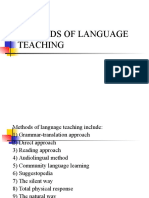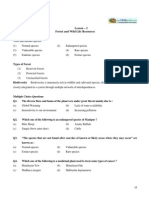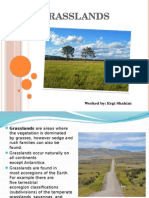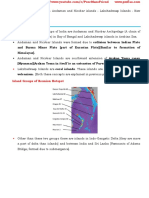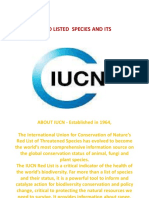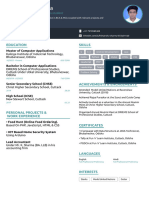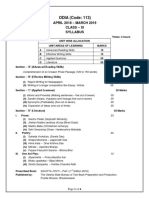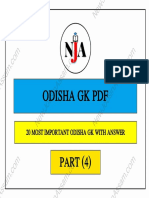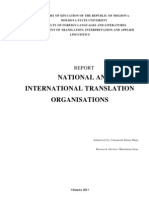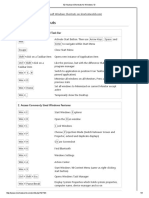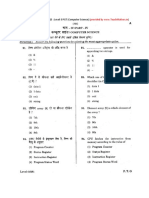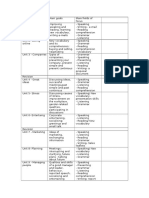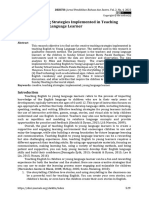CTET STUDY
NOTES
PRINCIPLES OF
LANGUAGE TEACHING
� Useful Links
Index
Sr. No. Topic’s Page No.
1. Language: Definition and Meaning 3
2. Characteristics of a Language 3
3. Aims of Language Teaching 3
4. Importance of Language 4
5. Importance of English Language in India 4
6. Principles/Methods of Language Teaching 4
7. Steps or Maxims Used While Teaching 5
8. Previous years CTET Principles of Language 6
Teaching
2
� Useful Links
Language: Definition and Meaning
Language is the most important aspect in the life of all beings. Language can be defined
as verbal, physical, biologically innate and a basic form of communication.
Language is a medium through which one can express one’s ideas, thoughts, feelings etc.
Different languages are spoken in the world. It is very difficult to ascertain how these lan-
guages originated. It is believed that people started conveying message through signals,
postures, gestures etc. So, we can say that language is a human system of communication
that uses arbitrary signals such as voice, sounds, gestures and written symbols.
According to Edward Sapir, "Language is a purely human and non-instinctive method of
communicating ideas, emotions and desires by means of system of voluntarily produced
symbols."
Thus, we can say that language is a method of human communication. It is a medium
through which expressions are given out with the use of complex structures.
Characteristics of a Language
Some of the important characteristics of language are given below
• Language is a set of conventional communicative signals used by humans for com-
munication in a community.
• Language consists of various sound symbols and their counterparts that are used
to point out some objects, occurrences and meanings. These symbols are chosen
arbitrarily and then they are conventionally accepted and employed.
• Although, language is symbolic, yet its symbols are arranged in a particular system.
All languages have phonological and grammatical systems and within a system there
are several sub-systems.
• Language is primarily made up of vocal sounds. So, speech is primary.
• There is no inherent relation between the words of a language and their meaning
or the ideas conveyed by them.
• Each language is unique in its Own sense. By this we do not mean that languages
do not have any similarities.
Aims of Language Teaching
Various aims of language teaching are as follows
• Ability to understand the speaker's language.
• Ability to read along with understanding.
• Ability to express fluently and diversely using different skills.
• Ability to present or write in a coherent manner.
• Ability to understand the scientific aspect of a language.
• Development of a learner's sensitivity towards national issues, cultural heritage and
different aspects of contemporary life.
3
� Useful Links
Importance of Language
• Language is a vital tool which serves as a means of communicating thoughts and
ideas. Language also forges friendships, cultural ties and economic relationships.
Some experts even say that "Language is that which separates human beings from
animals." Language is the most important means for acquiring human knowledge.
• Development of social contacts among the individuals has been possible due to use
of language through which men can easily exchange their ideas.
• Language also helps the spread of culture.
• Ideas require language. In the absence of proper words, ideas cannot be expressed.
So, language gives a capacity for conveying ideas about a great variety of things.
We can easily sum up by saying that language is the most important component of hu-
man life which can simplify the conveyance of ideas, smoothen social contacts, conserve
and preserve our culture and transmit it to posterity.
Importance of English Language in India
English has its unique importance in our country i.e. India. It is considered as the most
common foreign language which has played a crucial role in building modern India.
• In India, people speak different languages in different states so use of English
serves as a bridge to communicate with one another. It serves as a link language
and also helps us to link us to the outside world.
• English is also the primary language of press, internet etc. so to become technolog-
ically advanced, we must know English. It is an official language in over 50 coun-
tries around the world. It is used as an official language in United Nations also.
• Books, magazines and newspapers written in English outnumber those published in
any other languages.
• Most of the articles and books in science and Medicine are in English.
• Being an international language, it makes travel and business convenient to others.
In India, English is regarded as the second language so its importance cannot be
undermined.
Principles/Methods of Language Teaching
Many psychologists have laid down certain theories regarding language teaching. Some im-
portant theories or principles are as follow
1. Theory of Motivation and Interest Motivation is an important factor in lan-
guage learning particularly in learning a second language. The teacher can arouse
pupils' interest in a number of ways and language learning can be made increas-
ingly interesting. It can be done with the help of charts, pictures, flash cards, mod-
els, blackboard sketches and other similar visual devices.
4
� Useful Links
2. Theory of Imitation According to many psychologists, the child learns a lan-
guage through imitation. Imitation followed by intensive practice helps in acquiring
mastery over the language system.
3. Theory of Habit Formation 'Language learning' according to Palmer, "is a es-
sentially habit forming process, a process during which we acquire new habits."
Teacher can make language pattern as habit through intensive pattern practice in a
variety of situations.
4. Theory of Exercise (Practice and Drill) According to BF Skinner, psychological
experiments have proved that practising and drilling play an important part in lan-
guage teaching. Any learning, if it is continuously repeated, gets imprinted in child's
mind and he learns it efficiently. Teacher should make sure that repetitions of
things at proper intervals should be done.
5. Theory of Individual Differences Every child is unique and different from
others. In language teaching, we have to keep in mind that learners possess differ-
ent abilities, personalities and belong to different backgrounds. So, stimulus need of
every learner will be different. Teaching has to be done keeping in mind the individ-
uals differences and problems arising out of it.
6. Theory of Using Mother Tongue Some linguists are against the use of
mother tongue in teaching a foreign language. They believe that mother tongue
should be sparingly and judiciously used while teaching English. Of course, at an
early stage, some explanations will have to be given in pupils' mother tongue but at
latter stages inputs from the targeted language in a simple graded manner can help
in minimising the influence of mother tongue.
7. Theory of Oral Approach Speech motivates the learners to learn. Speech
must precede reading and writing. Introduction to lessons should begin orally as
learning to speak a language is always the shortest way of learning to read and
write it.
8. Theory of Ratio and Series Any language has certain basic skills. It is neces-
sary that teaching should be done in such a way that child is able to learn all
skills as listening, speaking, reading and writing and all these skills are correlated.
Deficiency in any one of the area will certainly create difficulties in learning a lan-
guage. So, teaching should be proportionate and all four language skills should be
integrated.
9. Theory of Child Centred Learning Efforts should be made to have a stu-
dent centred class as far as possible. Students should be given priorities while
teaching. A teacher should not get so absorbed in teaching that he/she may not
involve or interact with students. Teacher's focus should be on the child and teach-
ing should be done keeping in mind the child's needs.
Steps or Maxims Used While Teaching
Certain steps should be followed while teaching to make it more effective and gainful.
5
� Useful Links
1. Known to the Unknown Teaching should be carried on what the students
know either in their native language or in English. It is considered that old
knowledge lays the foundation of new knowledge.
2. Simple to Complex Simple things and vocabulary should be taught first before
proceeding to complex structures or vocabulary items. By learning simple things
learners feel motivated and confident that would certainly help in better understand-
ing of complex things.
3. Concrete to Abstract Concrete things are real things which can be seen and
felt by our senses. Abstract things can be just imagined. Teaching done with the
help of concrete objects lasts for a longer period e.g. a learner can imagine about
a golden apple only if he has seen an apple.
4. Analysis to Synthesis When teaching is done from detailed teaching to sum-
marising we go from analysis to synthesis.
5. Induction to Deduction In induction method, we give some examples first then
try to reach on a conclusion. In deduction, first of all a rule is explained then some
examples are given. Teaching should always precede from induction to deduction.
6. Psychological to Logical While teaching, the interests, aptitudes, capacities
and difficulty level of the learners should be kept in mind. e.g. vocabulary and sen-
tence structure of a language should be taught keeping in mind the difficulty level
of the learners and then they could be arranged and explained in a logical manner.
7. Relate form to Meaning and Contextualise All class activities should be
meaningful. Whatever activity the students are involved in, the students should be
able to understand the meaning of what they hear, say, read or write.
Previous years CTET Principles of Language Teaching
Q1. A teacher asks the learners to think, of ideas quickly about the topic ‘Save Water’ and
also asks them to note down their ideas before writing the article on ‘Save Water’. She is
focusing on
[CTET Sept 2016]
1)
2)
3)
4)
Answer: 2
Q2. Language is not
6
� Useful Links
[CTET Sept 2016]
1) instinctive
2) social
3) arbitrary
4) symbolic
Answer: 1
Q3. What is the ‘task’ in task-based language learning?
[CTET Sept 2016]
1) A piece of work which enables learners to do an activity
2) A piece of work for the parents to do their children’s homework
3) A piece of activity for teachers to do in the classroom
4) A piece of work which exposes learners to language
Answer: 4
Q4. Process writing approach could be described as
[CTET Sept 2016]
1) bottom-up approach
2) horizontal approach
3) top down approach
4) vertical approach
Answer: 1
Q5. Abeera, an English teacher, describes a scene and asks the learners to draw what
they have heard. This is a
[CTET Sept 2016]
1) mutual dictation
2) picture story
3) picture dictation
4) picture composition
7
� Useful Links
Answer: 3
Q6. Language is a tool because
[CTET Sept 2016]
1) it is used for processing ideas
2) it is used for communication
3) it is used for thinking
4) it is used for conveying ideas
Answer: 2
Q7. TBLT in second language teaching is
[CTET Sept 2016]
1) Tool-Based Language Teaching
2) Task-Book Language Teaching
3) Task-Based Language Teaching
4) Task-Based Language Training
Answer: 3
Q8. A teacher after completing a chapter asks the students some questions to review their
learning and check their understanding. The questions she is asking will be based on
[CTET Sept 2016]
1) lower-order thinking skills
2) hyper-order thinking skills
3) higher-order thinking skills
4) middle-order thinking skills
Answer: 3
Q9. Constructivism in language learning focuses on
[CTET Sept 2016]
1) the dominant role of the teacher in the classroom
8
� Useful Links
2) engaging learners in exploring new knowledge
3) the role of imitation
4) memorizing grammar rules
Answer: 2
Q10. The most important aspect of an effective language classroom is to provide learners
with an opportunity to
[CTET Sept 2016]
1) interact
2) interfere
3) assess
4) imitate
Answer: 1


